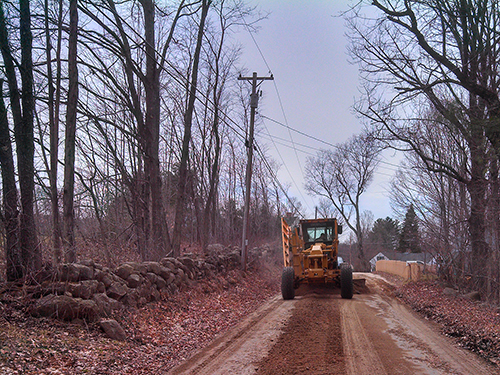
I am hoping that by the time you read this, mud season will be done with, and we will have unposted the roads. I wanted to take some time to explain why we do this and how mud season actually works.
In the fall as the temperature drops, the road surface freezes. If there is sub-surface water in the road bed, this also freezes and expands throughout the winter. Plowing the road surface bare causes the roadway to freeze deeper than the adjacent ground surface. In addition, ditch lines and other drainage structures separate road surfaces from the relative warmth of natural, snow-covered terrain.
The freezing of this sub-surface water makes the road bed rise slightly in the winter and is a part of what causes frost heaves in the spring.
In the spring, as the snow recedes, the surface of the road gets muddy and soft. This is caused by the upper layer of the road bed thawing. The water that thaws is trapped between the ice below it that is still frozen and the surface, and as a result it can’t drain easily. Worse yet, the edges of the road will thaw more quickly than the center, as the further you go from the center line of the road, the less frost there is in the ground.
These soft edges are why we post roads in the spring. While the center of some roads may support heavy traffic, these soft edges will not, at least not until the subsurface water has dried out. If a heavy truck passes over this soft ground, the wet ground will be squeezed out from underneath the load. If the road surface is paved, the pavement will fracture and break away. This is bad because once the pavement is cracked, water will now work its way into this weak spot and further degrade the road surface through expansion and contraction due to the daily freeze-thaw cycle in the spring.
Culverts are another point in the road that are susceptible to damage by heavy loads at this time of year. If a culvert has insufficient cover, it can be pushed up out of the road bed. A culvert is designed to be covered by gravel, which helps bear and disperse the weight of traffic. If this material is lacking, culverts can easily be crushed by heavy loads.
Also, culverts can move in the ground. If water fills the space opened up by this movement, it can cause hidden voids that can cause culvert failure. Even rocks moving in the subsurface can cause sink holes and localized settling.
If we limit the weight of traffic at this critical time of year and use a little courtesy, we can reduce the damage that occurs. On the dirt roads, try not to get off the edge of the road too far. Think of places where the road is the widest, and try to plan to pass other traffic at these locations.
Try to plan heating fuel deliveries so they don’t have to be made at this time of year. If you do need a delivery, please contact the Road Agent to be sure your road can support this weight. Often deliveries made in the early morning before the road has had a chance to thaw can be arranged if conditions are suitable.
Clear back brush and trees on your own property from the road surface. The more sunlight and air a road gets, the sooner it will dry out and be able to support regular traffic.
Keep your ditches and drainage clear. When water becomes trapped in drainage structures adjacent to the road, it can severely impact the amount of time it takes a road to dry out — sometimes, by weeks.
The Andover Highway Department is trying some new techniques to get the roads in better shape sooner. We have been putting out some gravel with one-ton trucks and a small loader to smooth the road surface. This enables us to address issues in the road surface sooner than if we used the Town’s heavy grader.
In the past, we have had to wait until road surfaces were sufficiently dry before we began smoothing out these ruts. By using a smaller five-ton loader and one-ton trucks, we are able to start repairing some roads as much as a month sooner than before. This allows us to prevent traffic and weather from making these roads worse than they might be.
As soon as the road surface is dry enough to support the grader, however, we will be back to grading them. The grader does a much better job at cutting potholes and prepares a much more uniform road surface.